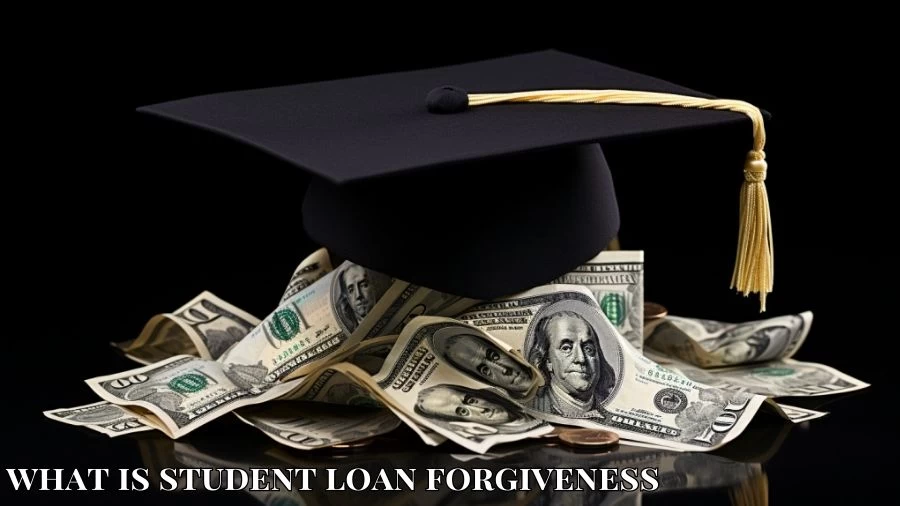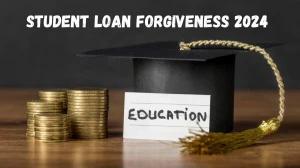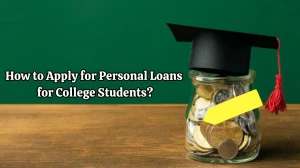
What is Student Loan Forgiveness and How to Apply for Student Loan Forgiveness?
Student loan forgiveness erases federal education debt for public service, under Biden's SAVE plan. Applying varies: Public Service yearly, Teacher Forgiveness after 5 years, NURSE Corps via HRSA online.
by Sai V
Published Aug 28, 2023 | Updated Aug 28, 2023 | 📖 14 min read
On This Page
- What is Student Loan Forgiveness?
- How to Apply for Student Loan Forgiveness?
- When Will Student Loan Forgiveness Be Applied?
- How to Get Student Loan Forgiveness?
- Who Qualifies for Student Loan Forgiveness 2023?
- When Will Student Loan Forgiveness Start?
- Department of Education Student Loan Forgiveness
- How Will Student Loan Forgiveness Be Paid for?
- Do I Qualify for Student Loan Forgiveness?
- Student Loan Forgiveness Status
- Student Loan Forgiveness Blocked
What is Student Loan Forgiveness?
Student loan forgiveness is a program designed to relieve borrowers from the responsibility of repaying a portion or even the entire amount of their federal student loan debt. This initiative is particularly relevant to individuals who have borrowed funds to finance their post-secondary education, such as college or university expenses. The underlying idea is to provide a pathway for individuals who might find themselves burdened by the financial strain of repaying these loans, allowing them to potentially have a significant portion of their debt forgiven.
It's important to note that the availability of loan forgiveness varies depending on the type of loan and specific criteria. Typically, borrowers who are working in certain public service, educational, or military fields are eligible for this benefit.
These sectors are often considered crucial for societal and national development. By offering loan forgiveness to professionals in these sectors, the government aims to incentivize individuals to pursue careers that contribute to public welfare and the betterment of society as a whole.
In the context of the recent announcement made by President Biden, a new income-driven repayment plan known as SAVE has been introduced as an alternative approach. This plan has been introduced in response to a Supreme Court decision that had an impact on the previous student loan forgiveness plan proposed by the President. SAVE stands for the new program's title and underscores its emphasis on enhanced financial benefits for student loan borrowers.
This innovative plan introduces several crucial features that are set to be rolled out gradually over the summer of 2023, with the comprehensive regulations taking effect from July 1, 2024. The SAVE plan represents a continuing effort to address the challenges associated with student loan debt and to provide more feasible repayment options for borrowers, aligning with evolving economic and legal considerations.
How to Apply for Student Loan Forgiveness?
When it comes to seeking student loan forgiveness, the application procedures can differ based on the specific program you're enrolled in.
Public Service Loan Forgiveness (PSLF):
To initiate the PSLF or Temporary Expanded PSLF (TEPSLF) forgiveness process, you should promptly complete and submit the PSLF & TEPSLF Certification & Application through the PSLF Help Tool to your designated loan servicer. It's advisable to carry out this submission annually and whenever you switch employers. Make sure to retain a copy of each submitted form for your personal records. Upon achieving ten years of qualifying service, you will finalize the PSLF by submitting a last form that necessitates verification from your current qualifying employer. This final form is sent to MOHELA, which is the federal loan servicer overseeing the PSLF program.
Teacher Loan Forgiveness:
Once you've fulfilled the requisite five-year service commitment, you can initiate the Teacher Loan Forgiveness Application process by submitting the appropriate form to your student loan servicer. The section requiring certification on the application must be completed by the primary administrative officer of your educational institution or agency. If you possess loans under the management of multiple servicers, you'll need to submit the form to each respective servicer.
NURSE Corps Program:
For those engaged in the NURSE Corps program seeking student loan forgiveness, the application can be completed online. Begin by setting up an account on the Health Resources & Services Administration's (HRSA) customer service portal. Prior to submitting your application, it's recommended to carefully review the guide provided to ensure accurate completion.
When Will Student Loan Forgiveness Be Applied?
The timeline for the implementation of student loan forgiveness is determined by the accumulation of qualifying months, with the exact duration contingent upon the borrower's loan type and their enrollment in an Income-Driven Repayment (IDR) plan. If a borrower has reached the equivalent of either 20 or 25 years of qualifying months, based on these factors, they become eligible for loan forgiveness.
This significant juncture in the process has been influenced by recent actions taken by the Biden-Harris Administration, particularly through the execution of a payment count adjustment.This adjustment, which was first announced in April 2022, has now materialized as a result of the administration's efforts.
The recent action, occurring on a Friday, signifies the administration's commitment to ensuring a fair and streamlined process for borrowers seeking loan forgiveness. By recalibrating the manner in which payment counts are tabulated, the administration seeks to provide borrowers with a clearer pathway toward accessing the benefits of loan forgiveness, ultimately easing the burden of student debt over extended periods of time.
How to Get Student Loan Forgiveness?
Strategies for alleviating student loan debt burdens and the potential avenues for loan forgiveness are subjects of concern, particularly in light of the substantial student loan debt faced by U.S. college graduates. Fortunately, graduates can explore options such as income-based repayment plans and forgiveness programs tailored for public service employees, aiming to mitigate the weight of their educational debts.
Explore Forgiveness Programs:
Begin by exploring the various options available for student loan forgiveness. These programs are designed to alleviate the burden of student loan debt for eligible borrowers. While the programs are limited, they offer significant relief if you meet their criteria.
Investigate Public Service Loan Forgiveness (PSLF):
One prominent pathway is the Public Service Loan Forgiveness (PSLF) program. This initiative erases the remaining student debt for individuals who have made consistent payments while working in public service roles. This involves an extended period of qualifying payments linked to your employment type.
Understand Income-Driven Repayment Plans:
Familiarize yourself with income-driven repayment plans, which can greatly assist in managing student loan debt. These plans adapt your monthly payments based on your income and family size. Plans like Income-Based Repayment (IBR), Pay As You Earn (PAYE), and Revised Pay As You Earn (REPAYE) may lead to forgiveness after a set number of years of on-time payments.
Consider Teacher Loan Forgiveness:
For educators in low-income schools or educational service agencies, Teacher Loan Forgiveness is an option. This program forgives a portion of federal student loans after fulfilling a specified duration of service.
Be Aware of Discharge Options:
Understand potential discharge options such as Closed School Discharge, which applies when a school closes during or shortly after your enrollment. Additionally, Total and Permanent Disability Discharge and Death Discharge are available under specific circumstances.
Explore Bankruptcy Possibilities:
While challenging, explore the potential of discharging student loans through bankruptcy if you can prove undue hardship. Meeting this stringent standard can lead to loan discharge through bankruptcy proceedings.
Consider Tax Implications:
Recognize that receiving loan forgiveness might have tax implications. The forgiven amount could be considered taxable income by the IRS, resulting in a tax obligation.
Check Eligibility Criteria:
Ensure that you meet the eligibility criteria for each forgiveness program. These requirements can encompass your type of employment, the number of payments completed, and other specific conditions.
Stay Informed:
Keep in mind that the landscape of student loan forgiveness is subject to change due to evolving policies and regulations. Stay informed about the latest updates from credible sources.
Seek Professional Guidance:
Before making any decisions regarding student loan forgiveness, consider seeking advice from financial advisors or student loan counselors. Their expertise can help you navigate the options and select the best course of action tailored to your unique circumstances.
Who Qualifies for Student Loan Forgiveness 2023?
To be eligible for student loan forgiveness in 2023, individuals must hold either direct loans or loans obtained through the Federal Family Education Loan (F.F.E.L.) program, all of which are overseen by the Education Department. This includes borrowers with Parent PLUS loans. However, meeting specific criteria is essential. Eligibility for debt cancellation hinges on having achieved a certain milestone, equivalent to either 20 or 25 years of qualifying months.
For the majority of borrowers, this translates to a requirement of 240 or 300 months of repayment under either an income-driven plan, where payments are linked to income and family size, or a standard repayment plan.The initiatives spearheaded by President Biden's administration concerning student debt relief are also noteworthy. In 2022, an announcement was made regarding potential cancellation of federal student loans, with a cap of up to $20,000 per individual.
Unfortunately, legal disputes have temporarily halted the implementation of this plan. Furthermore, the ongoing pause on federal loan repayments, initially instituted as a pandemic relief measure in March 2020, has seen multiple extensions. However, as part of a mutual agreement to raise the debt ceiling, this pause is slated to conclude no later than the end of August.
Notably, a novel income-driven repayment strategy, known as SAVE, was introduced on August 22, aiming to tie borrowers' monthly payments to their income and family size. This move is projected to substantially reduce federal payment burdens for countless borrowers.
The Biden administration has also exhibited targeted relief actions, erasing debts for specific groups like public service employees, individuals with permanent disabilities, victims of fraud, and those affected by sudden educational institution closures.
Additionally, efforts are underway to rectify errors made by loan servicing entities, leading to the potential elimination of $39 billion in debt for over 800,000 borrowers enrolled in income-driven repayment schemes. The actual count of qualifying payments necessary varies, contingent upon the type of loan and the specific payment arrangement selected by the borrower.
When Will Student Loan Forgiveness Start?
As the imminent conclusion of the student loan pause approaches, borrowers are confronted with a series of critical deadlines that warrant careful attention. The respite, officially concluding on August 31 following the enactment of legislation by President Biden, will mark the end of a three-year moratorium. As of September 1, interest will commence accruing once again. Subsequently, in September, loan servicers are slated to generate billing statements, with the inaugural monthly student loan payments scheduled for October.
Navigating these significant milestones is imperative, particularly for individuals seeking to optimize their financial standing amid the impending resumption of student loan payments. Among the pivotal dates to note, August 28 stands out as potentially the final opportunity for borrowers to seek reimbursements for any payments made during the duration of the student loan pause.
While some borrowers may have chosen to make voluntary payments during the moratorium, benefiting from the absence of accruing interest, those on a trajectory toward student loan forgiveness have limited incentive to exceed necessary payments. This sentiment is particularly pronounced due to the availability of benefits linked to the IDR Account Adjustment and Biden's innovative SAVE plan – options that were not present when the student loan pause was initially implemented in 2020.
Educational Department guidance underscores the possibility of obtaining refunds for the majority of payments, including those through auto-pay systems, made between March 13, 2020, and August 28, 2023. However, individuals with a Direct Consolidation Loan should be aware that payments made prior to consolidation are ineligible for reimbursement. To initiate the refund process, borrowers should establish contact with their respective loan servicers and formally request the reimbursement of their payments.
Department of Education Student Loan Forgiveness
The U.S. Department of Education has released an assessment regarding the financial implications of the Biden-Harris Administration's student loan forgiveness strategy. The proposal, unveiled in August, intends to alleviate the economic strain on working and middle-class families in the aftermath of the pandemic by granting eligible borrowers the opportunity to have up to $20,000 of their student debt pardoned.
According to the Department's evaluation, the execution of the Biden-Harris student loan forgiveness plan is anticipated to incur an average annual expenditure of approximately $30 billion over the next ten years. This allocation will encompass the debt relief provisions and associated administrative costs linked to providing this assistance to qualifying borrowers.
It's important to recognize that these details are grounded in estimations and forecasts furnished by the U.S. Department of Education, and the actual financial outcomes and effects of the program may undergo changes over time.
How Will Student Loan Forgiveness Be Paid for?
In this program initiative, individuals who have taken out student loans are required to make regular payments over a span of either 20 or 25 years, depending on the specific plan they've opted for under the Income-Driven Repayment (IDR) system. Once this predetermined payment period is successfully accomplished, the government pardons any outstanding balance remaining on the loans.
Borrowers of student loans are obligated to make regular payments for a fixed period, which can extend to either 20 or 25 years. The specific duration depends on the particular IDR plan that they have enrolled in. Upon the successful completion of this payment timeframe, any remaining balance on the loans is forgiven by the government.
Do I Qualify for Student Loan Forgiveness?
Wondering if you meet the criteria for student loan forgiveness? If you've been enrolled in repayment plans for federal direct loans or federal family education loans and have successfully completed either 20 or 25 years of eligible monthly payments, you could be eligible for loan forgiveness, depending on factors like your loan type, repayment plan, and origination date.
When it comes to qualification, certain conditions apply. Those who've opted for Income-Contingent Repayment (ICR), the oldest plan dating back to 1994, are more likely to be granted forgiveness. For other plans, such as Income-Based Repayment (IBR) established in 2009 (requiring 25 years of payments for eligibility), Pay-As-You-Earn (PAYE) introduced in 2012 (needing 20 years of payments), and Revised Pay-As-You-Earn (REPAYE) launched in 2015 (with either 20 or 25 years of payment criteria based on loan type), the necessary timeframe for forgiveness hasn't yet been met due to their relatively recent inception.
Student Loan Forgiveness Status
The prospects of achieving widespread student loan forgiveness within the Biden administration have hit a roadblock as the Supreme Court intervened, leaving the trajectory uncertain. However, efforts are underway to devise novel strategies in collaboration with the Department of Education to ensure a manageable approach when student loan payments eventually recommence.
A novel avenue being explored is the implementation of a fresh income-driven repayment plan named the SAVE plan, slated to replace the existing REPAYE plan by the summer of 2024. The Department of Education's blueprint for the SAVE plan aims to significantly reduce payments for undergraduate loans compared to other income-driven repayment plans, while simultaneously preventing borrowers' loan balances from ballooning, provided they adhere to mandatory payments.
Furthermore, the SAVE plan seeks to allocate a greater portion of borrowers' earnings for essential needs.A notable facet of the SAVE plan is its provision for individuals with limited income. Those earning less than $15 per hour, according to the administration's outline, will be exempted from making payments under this new scheme. Existing REPAYE plan participants will seamlessly transition to the forthcoming SAVE plan, with applications for the latter set to open later in the summer of 2023.
Following a hiatus spanning over three years, recipients of federal student loans will be required to resume loan repayments in 2023. Interest accrual will commence from September 1, and borrowers will be obligated to initiate payments starting October. As the situation continues to evolve, it's advisable to stay abreast of updates from authoritative government sources and dependable news channels, as finer details and timelines might undergo changes.
Student Loan Forgiveness Blocked
The US Supreme Court has blocked President Joe Biden's initiative to introduce a $400 billion plan aimed at canceling or reducing federal student debt. The court's decision, with a 6-3 split along ideological lines, asserts that the President went beyond his authority by attempting to use the 2003 Higher Education Relief Opportunities for Students Act (HEROES Act) to justify his proposal. The majority opinion, written by Chief Justice John Roberts, focuses on the issue of authority rather than the need for debt relief.
President Biden, disagreeing with the court's ruling, argued that the Constitution had been misinterpreted. In response, he unveiled alternative measures to aid student loan borrowers, ensuring that the education department would not refer borrowers to credit agencies for a 12-month period. Despite the setback, Biden expressed his unwavering determination to explore other avenues for addressing student debt challenges.
What is Student Loan Forgiveness - FAQs
1. What is Student Loan Forgiveness?
Student Loan Forgiveness is a program relieving borrowers from repaying federal student loan debt based on eligibility.
2. Who qualifies for Student Loan Forgiveness?
Those with federal loans who make eligible payments for 20-25 years.
3. What's the recent Student Loan Forgiveness SAVE plan?
The Student Loan Forgiveness SAVE plan is an income-driven repayment plan aiming to reduce federal loan payments.
4. What's the 2023 Student Loan Forgiveness status?
The Student Loan Forgiveness plan blocked; alternatives explored.
5. When do payments resume after the Student Loan Forgiveness pause?
Student Loan Forgiveness payments resume Oct 1, 2023; interest from Sept 1.




